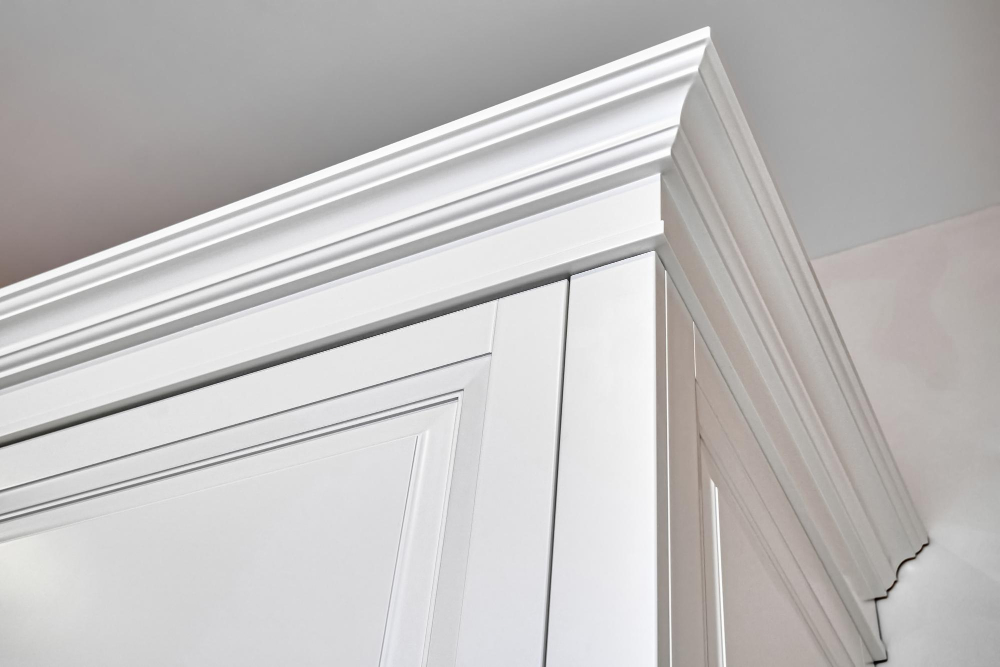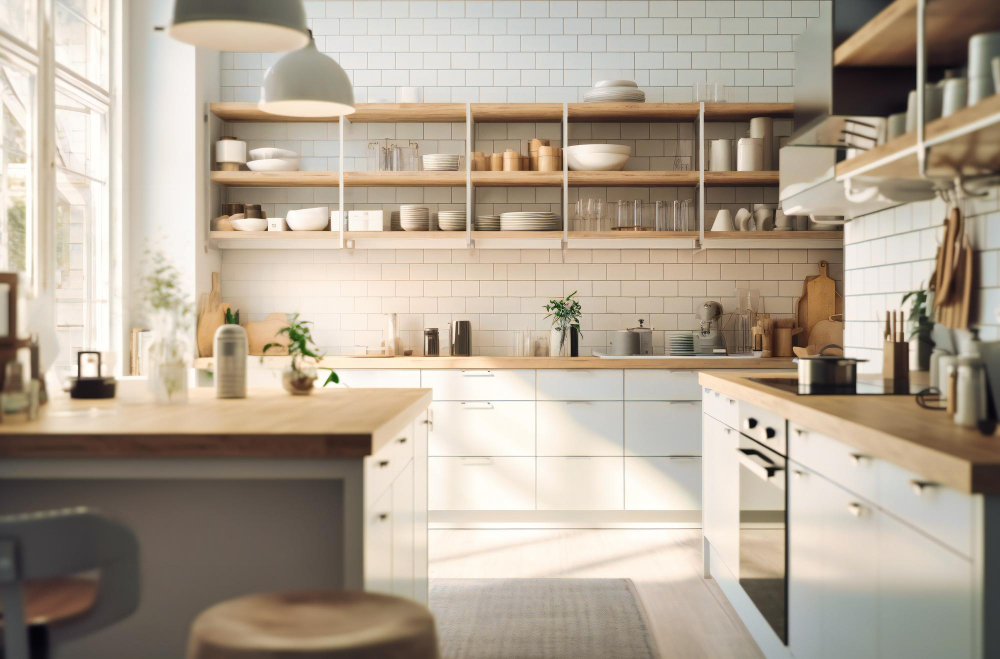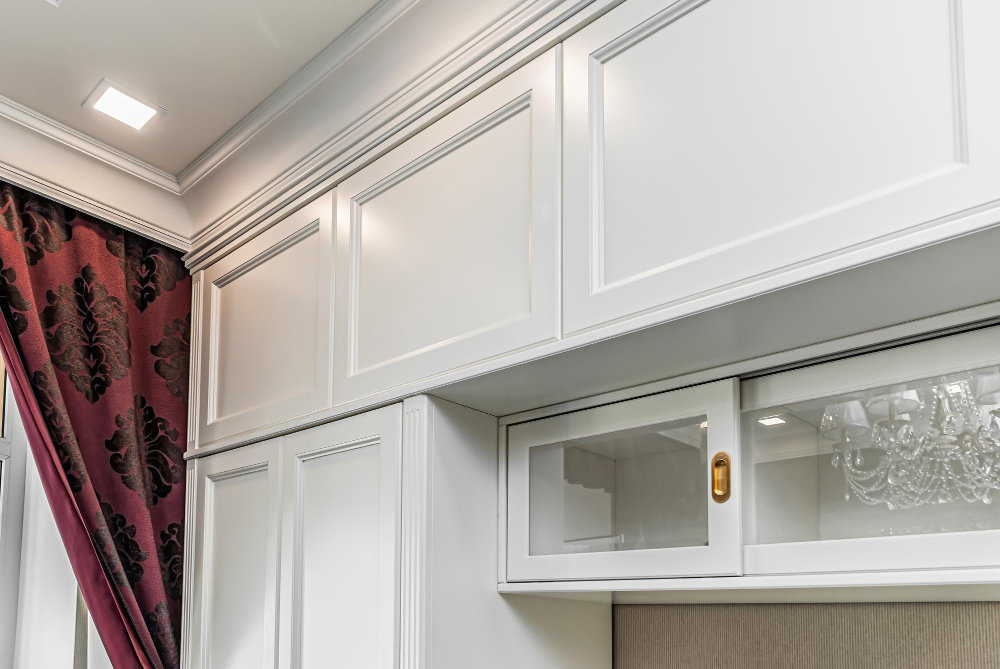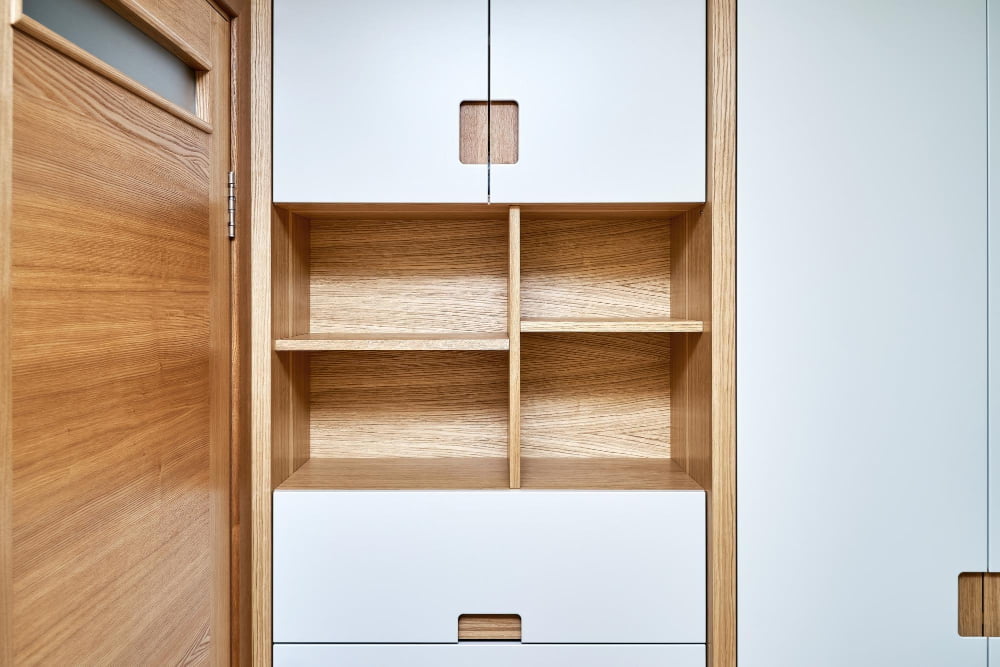Last updated on
Discover fantastic cabinet molding options right here. Enhance your kitchen’s aesthetic appeal and elevate its overall design in this comprehensive guide.
Cabinet molding is a simple yet effective way to add character and style to your kitchen or bathroom cabinets.
It’s a small detail that can make a big impact on the overall look of your space. However, with so many options available, it can be overwhelming trying to decide which one is right for you.
That’s why I’ve put together this list of unique cabinet molding ideas that will inspire you to get creative and transform your cabinets into something truly special. Whether you’re looking for something traditional or modern, subtle or bold, there’s sure to be an option on this list that will suit your taste and budget.
So let’s dive in!
Crown Molding
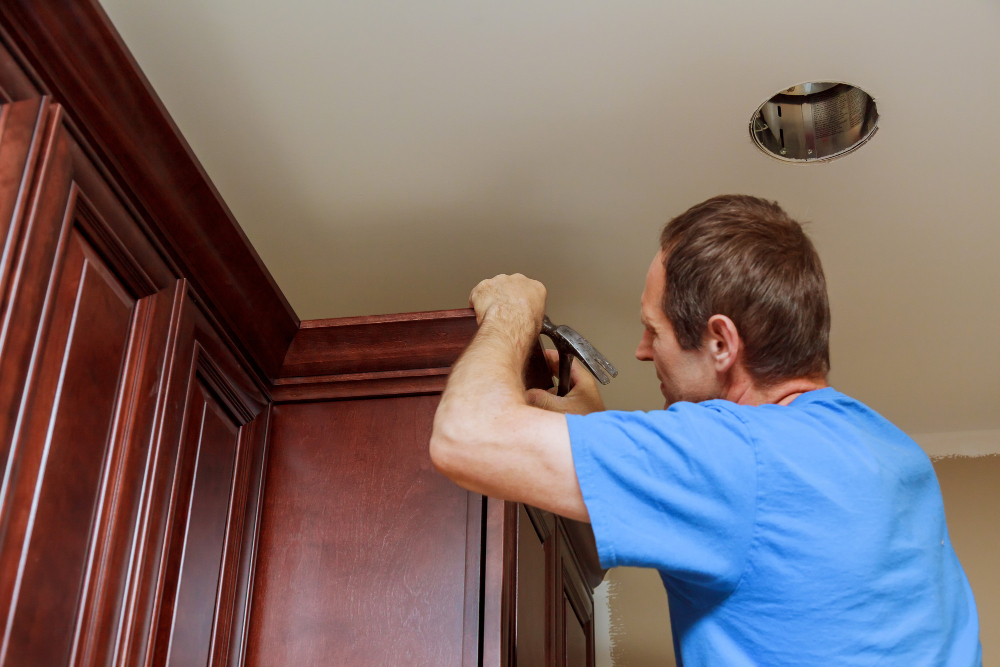
Crown molding is a popular option for adding elegance and sophistication to kitchen cabinets. It is installed at the top of the cabinet, where it meets the ceiling, creating a seamless transition between them.
Crown molding comes in various sizes and styles, from simple designs to more intricate ones with curves and details that can match any decor style.
One tip when choosing crown molding for your cabinets is to consider the height of your ceilings. Higher ceilings can accommodate larger crown moldings while lower ones may require smaller or simpler designs.
Another consideration when installing crown molding on cabinets is whether you want it flush with or extending beyond the face frame of your cabinetry. Flush installation creates a clean look while extended installation adds depth and dimensionality.
Light Rail Molding
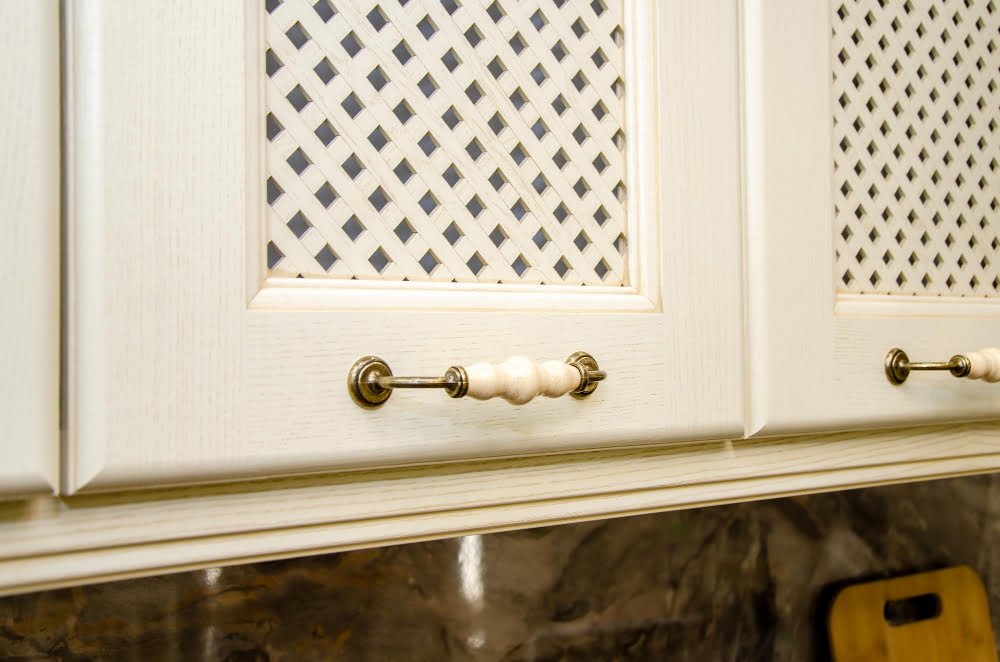
It serves two purposes: it hides under-cabinet lighting fixtures and provides a finished look to the cabinetry. Light rail moldings are available in various styles, from simple and sleek to ornate and decorative, making them an excellent option for any kitchen style.
One popular light rail molding design features a curved profile that adds elegance to traditional or transitional kitchens. Another option includes straight-edged light rails with beveled edges for modern kitchens.
When selecting light rail moldings, consider their compatibility with your chosen under-cabinet lighting system as well as their color match with your cabinetry finish. Installing these moldings requires precision cutting and fitting; therefore, it’s best left to professionals unless you have experience working with power tools like saws or routers.
Baseboard Molding
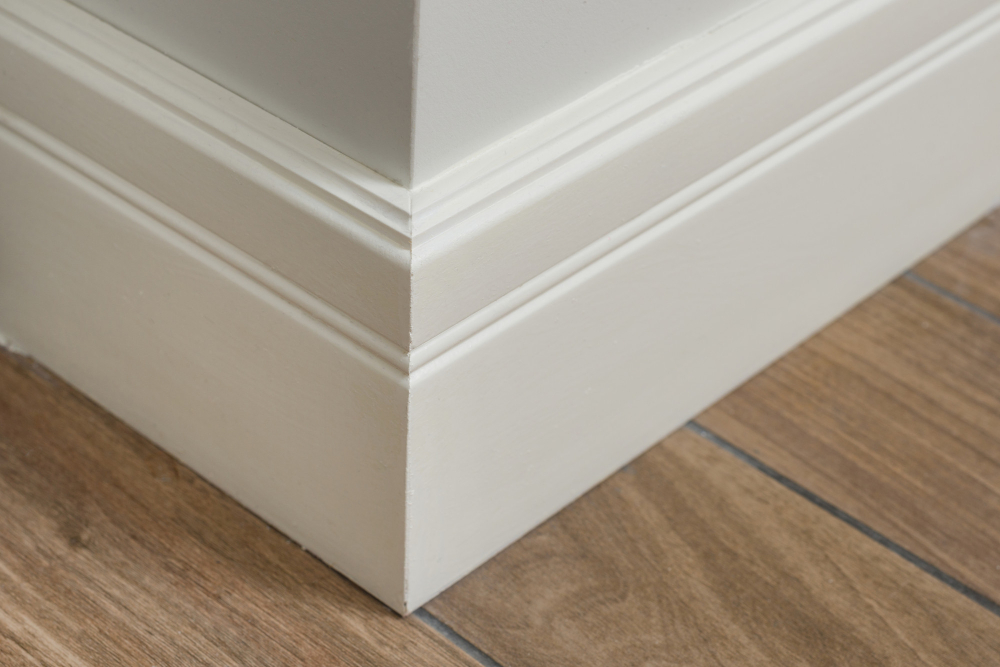
It is installed at the bottom of the cabinet and covers any gaps between the cabinet and floor. Baseboard molding comes in various styles, from simple designs to more ornate ones with intricate details.
Some baseboards are flat while others have curves or angles that add depth and dimension to your cabinetry.
One advantage of using baseboard molding is that it can help protect your cabinets from moisture damage caused by spills or leaks on the floor. It can make cleaning easier as dirt and debris won’t accumulate in those hard-to-reach areas under your cabinets.
When choosing baseboard moldings, consider factors such as color, material type (wood vs PVC), height, width, profile shape (curved vs straight), texture (smooth vs rough) among others depending on what suits best for you decor style.
Rope Trim Molding
It features a twisted rope design that can be used as an accent or border around the perimeter of the door panel. This type of molding works well in traditional or coastal-style kitchens, but it can also add character to modern cabinets when paired with sleek hardware and finishes.
Rope trim moldings come in various sizes, from thin cords to thicker ropes, allowing you to choose the right scale for your cabinetry. They are typically made from wood or resin materials and come pre-finished or ready for painting.
To install rope trim molding on your cabinets, measure the length needed for each section and cut at 45-degree angles using a miter saw. Apply wood glue along one edge of the molding before pressing it onto your cabinet door frame.
Secure with finishing nails every few inches until fully attached.
Dentil Molding
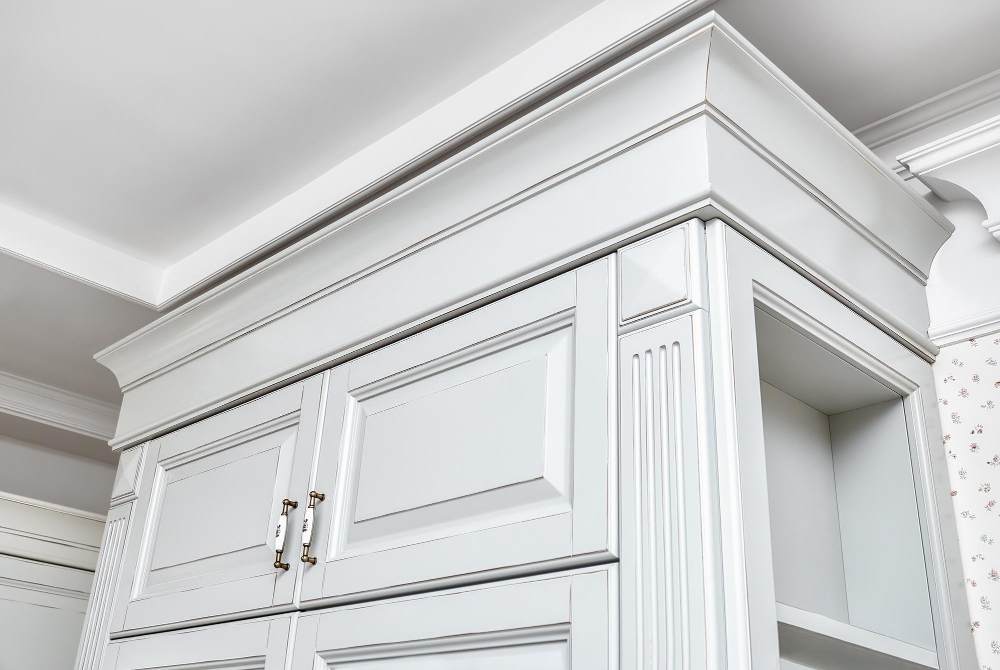
It features small, rectangular blocks that are evenly spaced along the length of the molding. The name “dentil” comes from the Latin word for tooth, which describes the appearance of these small blocks.
This type of molding adds depth and texture to cabinets while still maintaining a clean and simple look. Dentil moldings can be used on both upper and lower cabinets or as an accent piece in between two different types of moldings.
One thing to keep in mind when using dentil molding is that it requires precise installation due to its repetitive nature.
Egg and Dart Molding

It features alternating egg-shaped and V-shaped elements, creating a repeating pattern along the length of the molding. This type of cabinet molding adds an elegant touch to any kitchen or bathroom cabinetry, giving it a timeless look.
Egg and dart moldings are available in various sizes, making them suitable for different types of cabinets. They can be made from wood or composite materials like polyurethane foam or PVC plastic.
One advantage of using egg and dart moldings is that they can be painted to match any color scheme you have in mind. You can also use them as standalone pieces on furniture such as bookcases or mantels.
Fluted Trim Moldings
They feature vertical grooves that run the length of the molding, creating a textured look that adds depth and interest to any space. Fluted trim moldings can be used on their own or combined with other types of molding for a more intricate design.
One popular way to use fluted trim moldings is as an accent piece on kitchen cabinets. By adding fluted columns or pilasters to either side of your cabinets, you can create a custom-built look without breaking the bank.
Fluted crown molding is another great option if you want to add some visual interest at the top of your cabinets.
When it comes to finishes, fluted trim moldings work well in both painted and stained applications. If you’re going for a more traditional feel, consider using them in natural wood tones like oak or cherry.
For something more modern, try painting them white or black.
Beaded Panel Moldings
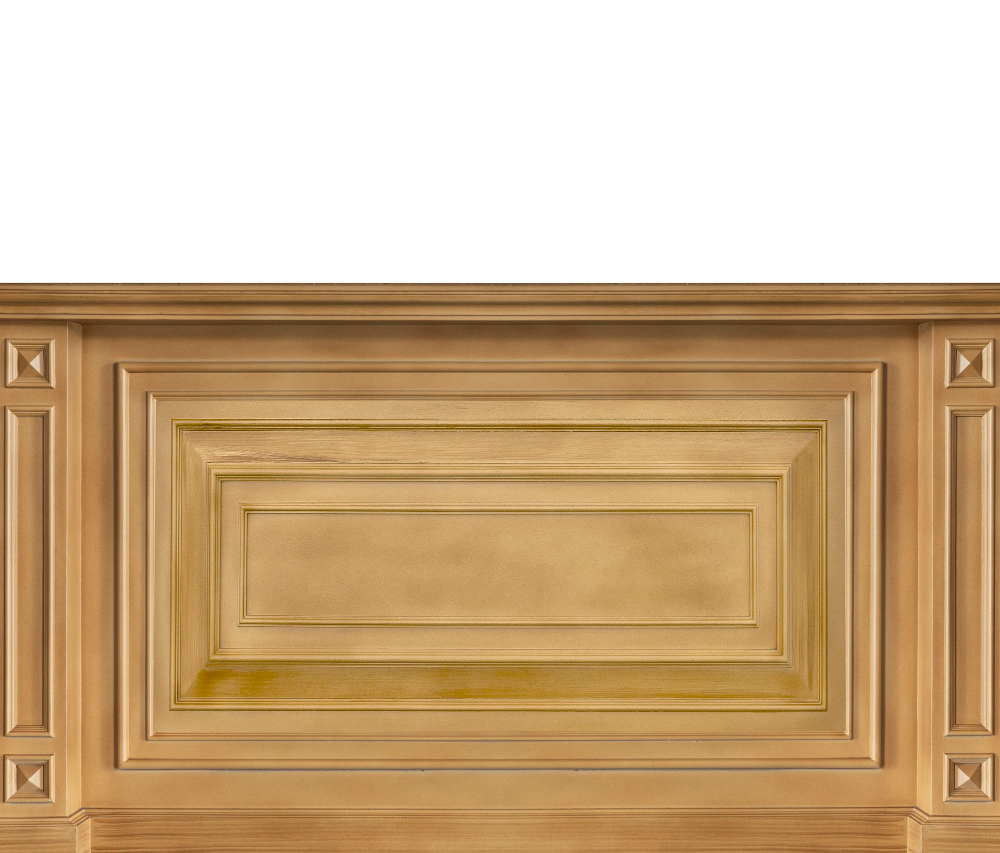
These moldings feature a series of small beads that run along the edge of the panel, creating an elegant look that is perfect for traditional or transitional kitchens.
One popular option is to use beaded panel molding on just the upper cabinets, leaving the lower cabinets plain. This creates visual interest without overwhelming the space.
Another idea is to mix and match different types of molding on your cabinets. For example, you could pair beaded panel molding with crown molding for a more elaborate look.
When choosing beaded panel moldings, consider their size and spacing in relation to your cabinet doors. Larger beads will create a bolder statement while smaller ones will provide subtle detail.
Corner Blocks or Rosettes
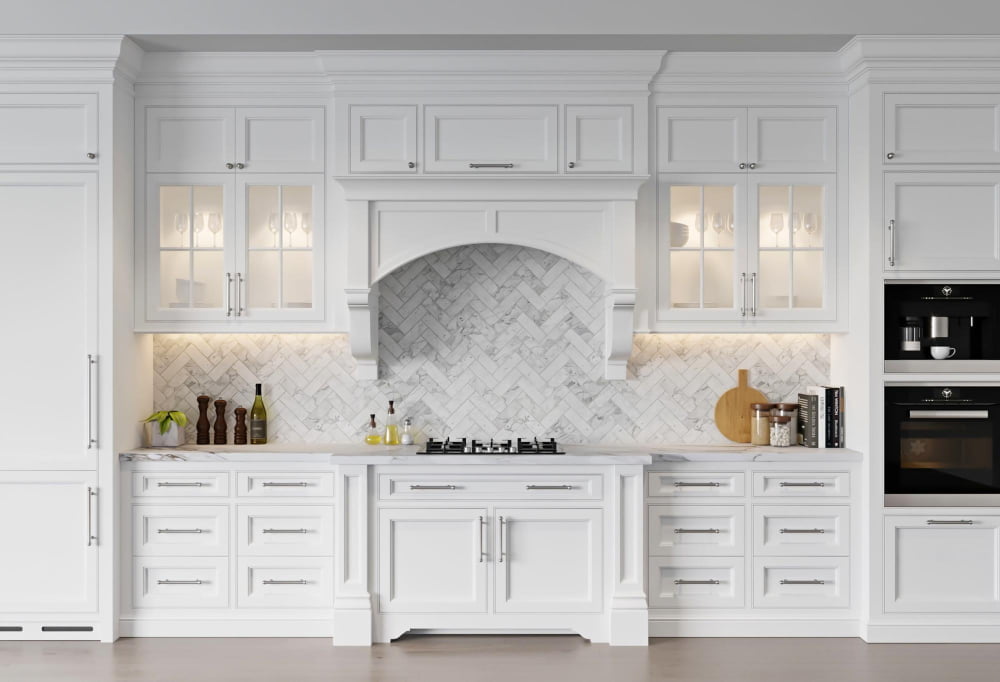
These small, circular pieces of wood are typically placed at the corners where two pieces of molding meet. They not only provide a seamless transition between different types of molding but also serve as an eye-catching detail.
Corner blocks come in various sizes and designs, from simple round shapes to more intricate patterns with carved details. They can be painted or stained to match the color scheme of your cabinets and room decor.
One advantage of using corner blocks is that they eliminate the need for miter cuts on crown molding, which can be challenging for beginners. Instead, you simply butt one piece against another at 90 degrees and attach them both onto the block with glue or nails.
Rosettes work similarly but are usually larger than corner blocks and have more elaborate designs such as flowers or leaves carved into them. They’re often used in conjunction with other moldings like baseboards or chair rails rather than just crown molding alone.
Picture Frame Moldings
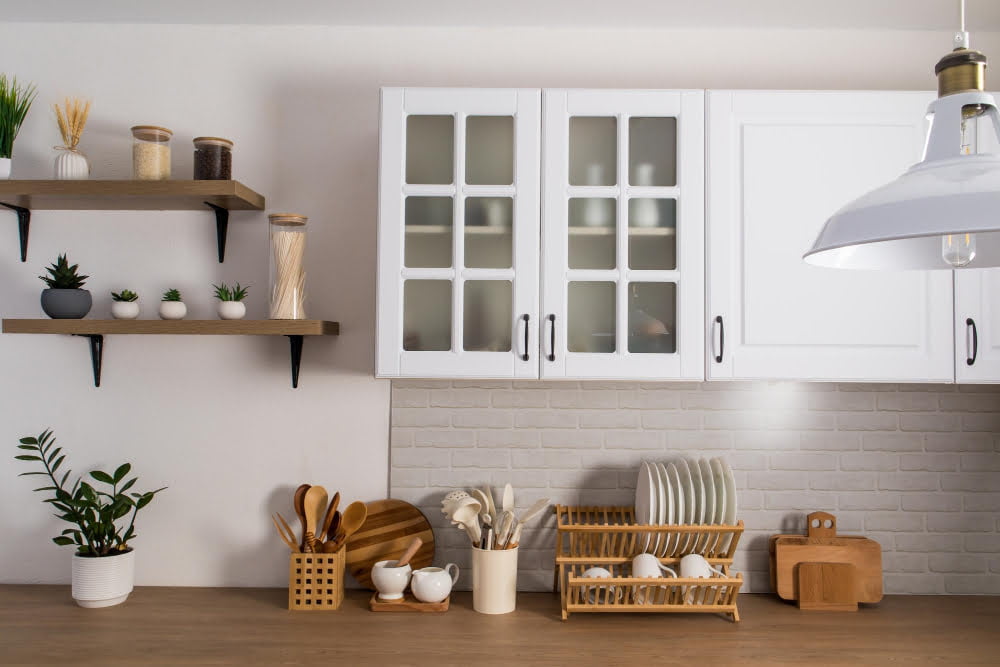
These moldings create the illusion of a picture frame around the center panel of your cabinets, adding an elegant touch to any kitchen or bathroom. Picture frame moldings come in various styles, from simple and sleek designs to more ornate options with intricate details.
They can be painted or stained in different colors for added customization. Installing picture frame molding is relatively easy and can be done as a DIY project with some basic tools such as saws, nails, glue, and clamps.
With this option for cabinet molding design you will have beautiful cabinetry that looks like it was custom made without breaking the bank!
Wainscoting Panels
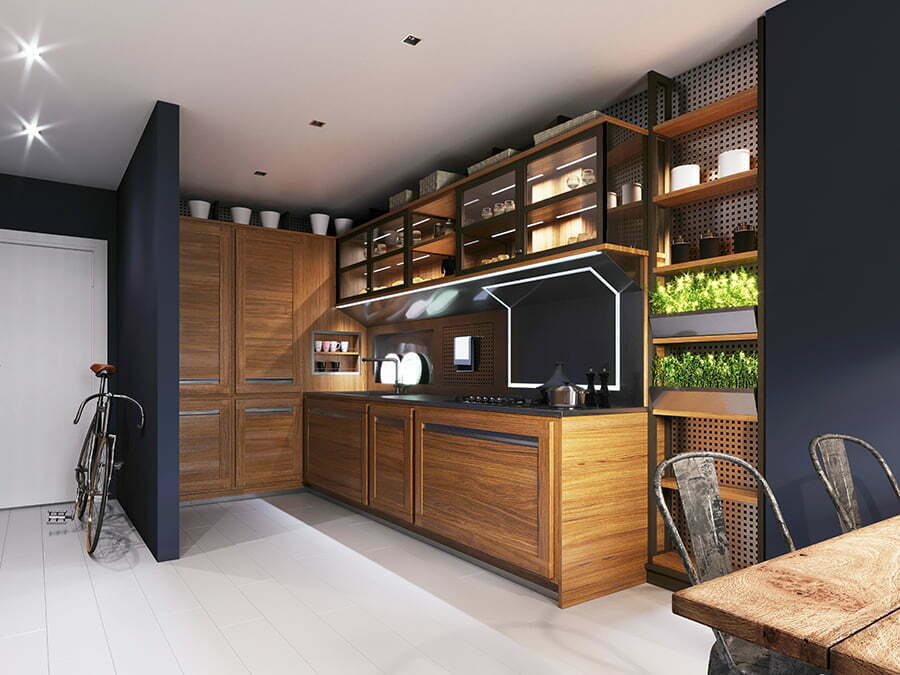
They add depth and texture to the cabinets, making them stand out in any room. Wainscoting is typically made of wood or MDF (medium-density fiberboard) and can be painted or stained to match the rest of your decor.
There are several types of wainscoting panel designs available, including raised panel, flat panel, beadboard, and shaker style. Raised-panel wainscotting features a center panel that is elevated above the surrounding frame with decorative edges around it.
Flat-panel wainscotting has a simple design with no raised elements on its surface.
Beadboard-style wainstocing features narrow vertical planks separated by grooves called “beads.” This type of design adds visual interest without being too busy or overwhelming in appearance.
Shaker-style wainstocing has clean lines that create an understated look while still adding dimensionality to your cabinetry.
Astragal Edge Profiles
This type of molding features a rounded profile with two parallel beads running along its length, creating an elegant and classic look. Astragal edge profiles work well on both traditional and modern style cabinets, adding depth and dimension to any design.
One great way to use astragal edge profiles is by installing them on the outer edges of glass-fronted cabinets or open shelving units. The rounded profile helps soften the sharp lines created by these types of storage solutions while also providing visual interest.
Another option is using astragal edge profiles as trim around kitchen islands or peninsulas. This can help tie together different elements in your kitchen design while also adding texture and detail.
Ogee Edge Profiles
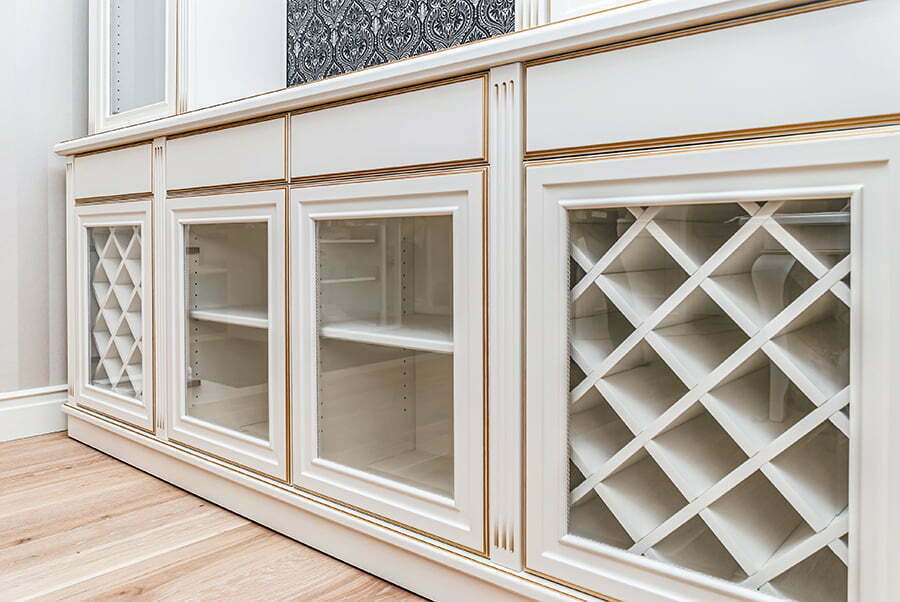
This type of molding features an S-shaped curve that adds depth and dimension to the cabinets. Ogee edges can be simple or ornate, depending on the desired look.
They work well with traditional and transitional styles, but can also add a touch of elegance to modern designs.
One benefit of ogee edge profiles is their versatility – they can be used on both upper and lower cabinets as well as on islands or other built-in furniture pieces in your kitchen or bathroom. Ogee edges come in various sizes so you can choose one that fits your specific needs.
When selecting an ogee profile for your cabinetry project, consider the size of your space and existing design elements such as flooring style or wall color scheme to ensure it complements rather than clashes with them.
Cove Profile Edges
This type of molding features a concave curve that creates an elegant and timeless look. Cove moldings can be used on the top or bottom edge of cabinets, as well as on the face frame or doors.
One advantage of cove profile edges is their versatility. They work well with both traditional and modern styles, depending on the finish and color chosen.
For example, white-painted cove moldings can give cabinets a classic look while black-painted ones create a more contemporary feel.
Another benefit is that they are relatively easy to install compared to other types of cabinet moldings such as crown molding or dentil trimmings. Cove profiles come in various sizes so you can choose one that fits your specific needs.
S-curve Edging
This type of molding features an S-shaped curve that adds depth and dimension to your cabinets. It’s perfect for adding a touch of elegance to any room in your home.
One great thing about S-curve edging is that it can be used on both the top and bottom edges of your cabinets, creating a cohesive look throughout the space. You can also choose from different sizes and styles, depending on the overall aesthetic you’re going for.
When it comes to installation, S-curve edging requires some skill but with patience anyone can do it themselves or hire someone who specializes in this type of work.
Inverted Baseboard
This type of molding is installed upside down, with the flat edge facing up and the decorative edge facing down. The result is a subtle yet stylish detail that can make your cabinets stand out from the rest.
Inverted baseboard moldings are available in various styles, including simple straight lines or more intricate designs with curves and angles. They can be made from different materials such as wood, MDF (medium-density fiberboard), or PVC (polyvinyl chloride).
One advantage of inverted baseboards over traditional ones is their ability to hide under-cabinet lighting fixtures while still providing an elegant finish at the bottom of your cabinetry.
Appliques and Onlays
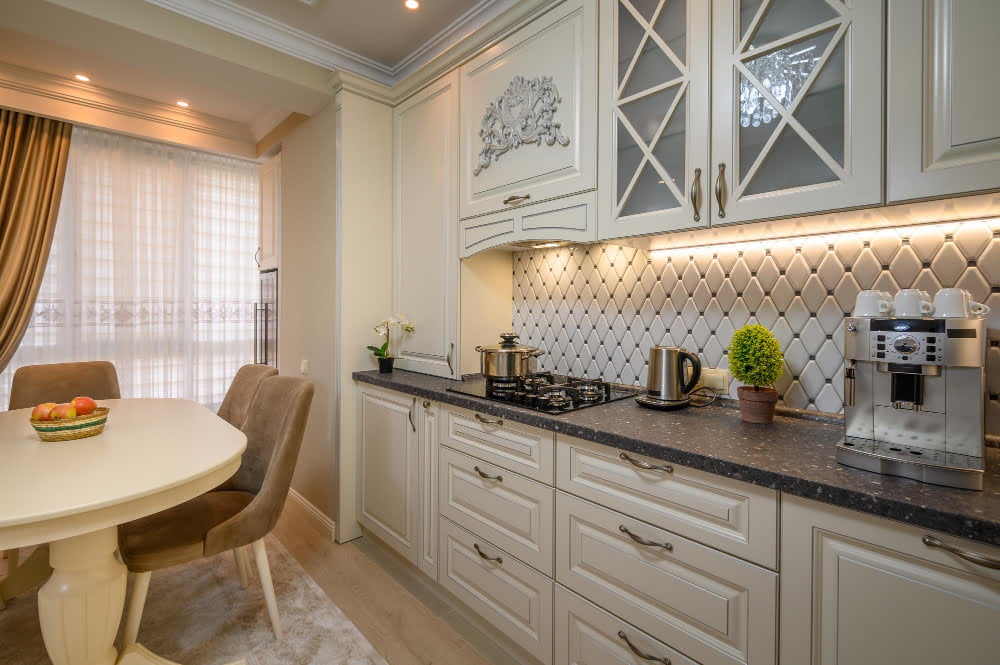
They come in a variety of shapes and sizes, from simple floral designs to intricate scrollwork. Appliques are typically made of wood or resin and can be painted or stained to match the rest of your cabinetry.
Onlays are similar but tend to be larger than appliques. They often feature more detailed designs such as cherubs, leaves, or other ornate patterns.
Onlays can also be used as a focal point for your cabinets by placing them in the center panel of a door.
Both appliques and onlays add depth and dimensionality to plain cabinets without breaking the bank.
Furniture-style Feet
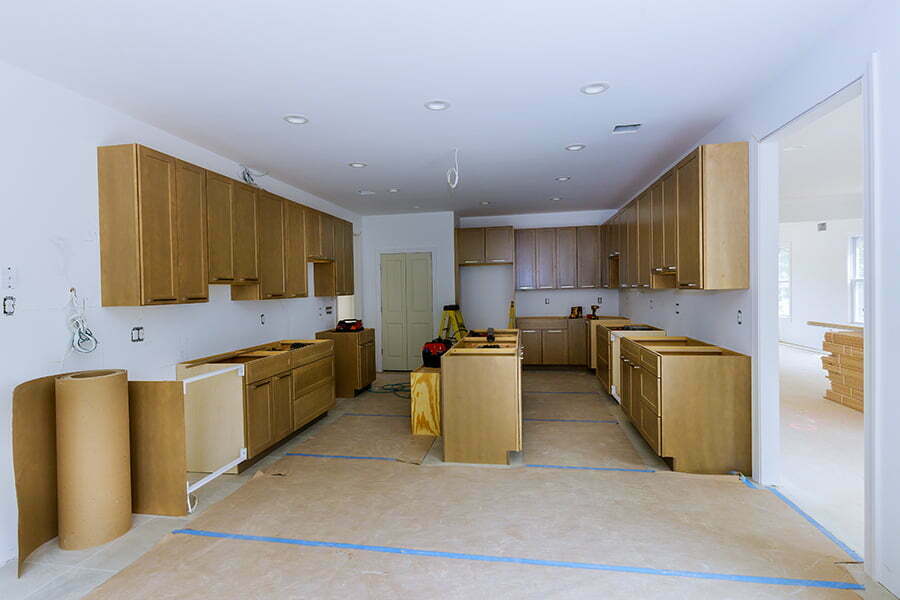
These decorative elements can be added to the bottom of your cabinet, giving it a furniture-like appearance. Furniture-style feet come in various styles, including bun feet, claw-and-ball feet, and tapered legs.
Bun feet are round or square-shaped with a flat top that attaches directly to the cabinet base. They give off an antique look and work well with traditional or rustic decor styles.
Claw-and-ball furniture style-feet have intricate details that resemble animal claws holding onto balls at their base. This type of foot is perfect for adding sophistication and grandeur into any space.
Tapered legs offer clean lines while still providing visual interest through their shape variation from top-to-bottom; they’re ideal for modern spaces where simplicity is key but you still want some detail on your cabinetry.
Glass Door Inserts
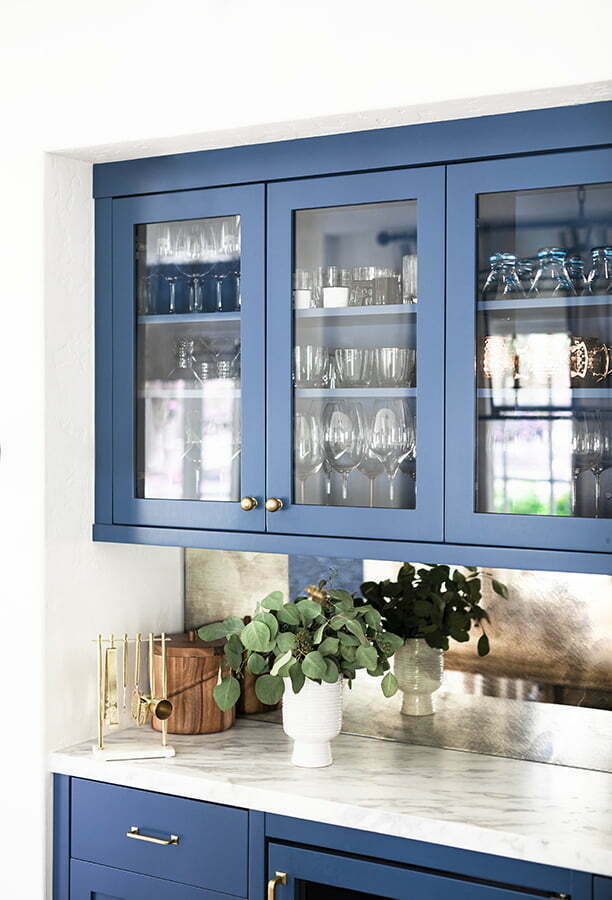
They come in various styles, including clear, frosted, textured or stained glass. Clear glass is perfect for displaying your beautiful dishware or collectibles while frosted or textured glass can provide privacy and hide the contents of the cabinet.
Stained glass inserts can also be used as an art piece on their own with intricate designs that complement any decor style. Glass door inserts work well in both traditional and modern kitchens adding a touch of classiness.
If you have existing cabinets without doors, consider retrofitting them with custom-made doors featuring decorative glass panels. This will not only enhance the look of your kitchen but also increase its value if you ever decide to sell it.
Decorative End Panels
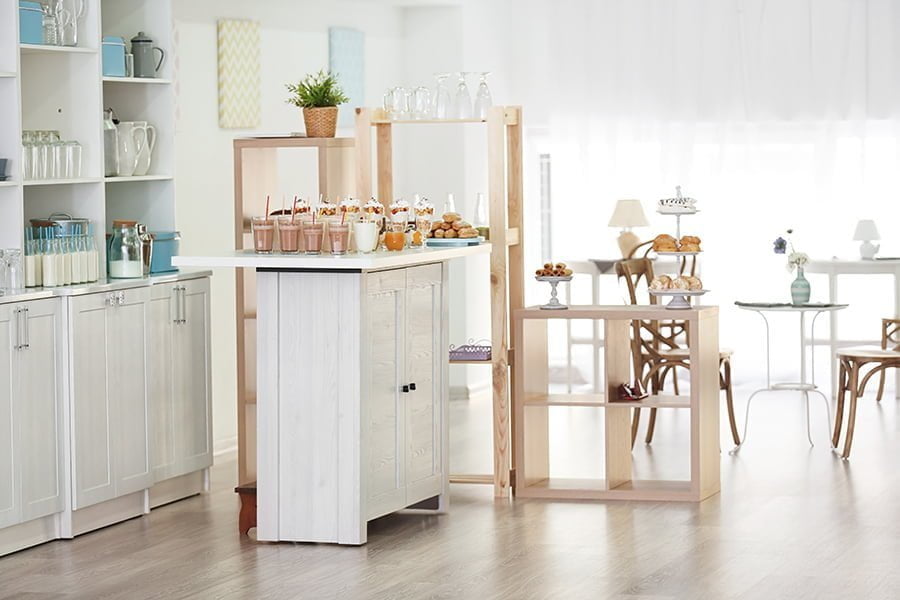
These panels can be made from a variety of materials, including wood, glass, metal or even fabric. They come in different shapes and sizes that can fit any cabinet design.
One popular option is using decorative end panels with intricate cutouts or patterns that allow light to pass through them. This creates an interesting visual effect while also adding depth and texture to the cabinets.
Another option is using textured materials like woven rattan or grasscloth for the paneling. This adds warmth and natural elements into your kitchen decor.
If you want something more modern, consider using sleek metal sheets as decorative end panels for an industrial look.
Decorative end panels offer endless possibilities when it comes to customizing your cabinetry design while staying within budget constraints.
Recap
Liked this article? Here's what you can read next:
